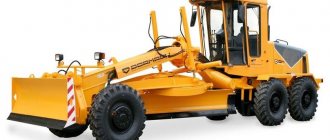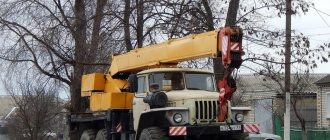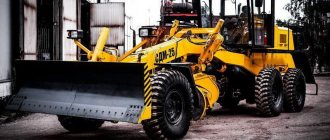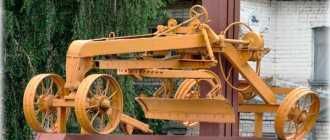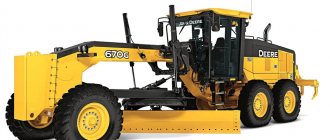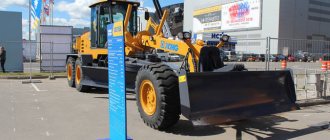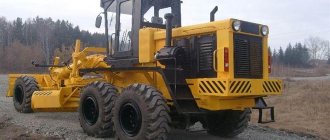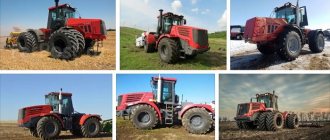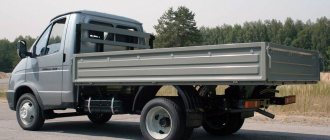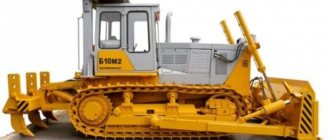Technical characteristics of the motor grader DZ-180
Before the collapse of the Soviet Union began, Bryansk began production of a new product line, the DZ-180 motor grader. The engineer decided to take the DZ-143 series motor grader, which was popular at that time, as a basis. In general, the result was a kind of copy of a motor grader, which had common units and components with the DZ-153 model. According to its classification, the DZ-180 grader belongs to the middle range of special equipment that works exclusively with soils. The main advantage is the unique design of the machine, which is combined with an equally powerful engine provided in this model.
Areas of application of motor grader equipment
Like most of its brothers, the technical characteristics of the DZ-180 motor grader are designed to perform the following operations:
- For the arrangement of the road surface. The design of the machine includes a bulldozer blade, which uses an auxiliary grader blade with built-in turntables, which also has a ripper-picker design that has a fairly wide range of operating capabilities. These characteristics allow the grader to be used for working with soil that belongs to categories I, II, III and has complex terrain characteristics.
- Using unique special equipment, you can work on difficult sections of the road with non-standard terrain characteristics.
- Special equipment motor grader DZ-180A is used to form a special trough device for the road surface.
- An excellent version of the technique, which is designed for mixing soil, including the use of additives.
- In addition to traditional SDR, the DZ-180 grader with a rear axle is also used when carrying out cleaning activities on the road, cleaning roadsides, city streets and squares.
- Using a ripper and a picker, you can open up worn-out asphalt and cobblestone road surfaces.
- In the road industry, the machine is used to design roadsides, adjacent ditches, as well as to design the adjacent area to the road surface.
Specifications
Grader DZ-180 - manufacturer. The Bryansk Arsenal is intended for performing earthworks for the construction of road subgrades, erecting embankments, leveling areas, constructing road troughs, as well as for mixing soils with additives and binding materials on the road surface. The DZ-180 auto grader is used for repairing and maintaining roads and roadsides, clearing them of snow, loosening asphalt surfaces, cobblestones and heavy soils. Motor grader DZ-180 can operate on soils of categories I - III at ambient temperatures of -40°C...+40°C in temperate and tropical climates.
The DZ-180 modification is similar in design to the DZ-143 , and has many standardized components.
The DZ-180 motor grader is equipped with an Internal Combustion Engine A-01 with an electric starter or an ICE A-01M with a starting motor, as well as an ICE D-260 2 with an electric starter. The Grader DZ 180 is equipped with a powerful Ripper-Picker DZ-180 located at the rear.
The DZ-180 was equipped with three types of gearboxes: a Hydro Mechanical Transmission (HMGC) with 4 forward and 2 reverse gears; mechanical with six forward gears, with a gear ratio in top gear i = 0.62 and two back, Manual Transmission (MT) with six forward gears and a gear ratio in top gear i = 0.835 and two back.
Currently, the DZ-180 motor grader has been discontinued and is no longer available.
This is interesting: John Deere 772G grader
How the DZ 180 grader works
A three-axle unit on pneumatic tires of the middle class with a 1x2x3 wheel arrangement, having a power unit and transmission units for driving the road wheels, as well as ensuring the operation of the hydraulic system pumping unit.
Wheel formula parameters: 1 - number of controlled axles; 2 – number of driving axes, 3 – total number of axes. On heavy class graders, the formula 1x3x3 is used.
Basic mechanisms and structural elements
- The frame on which the grader mechanisms are mounted rests on a balancing trolley with drive wheels at the rear and is connected at the front to the axle of a pair of wheels controlled by hydraulic cylinders. The middle part of the frame device is the spinal beam, curved with a hump and narrow in plan, intended for attaching the hinge of the traction frame. On which a moldboard device controlled by hydraulic cylinders is installed - the executive body of the machine.
- Transmission units of mechanical and hydromechanical types.
The first ones consist of a clutch mechanism, a gearbox for selecting the amount of torque on the drive wheels, cardan devices and gearboxes for transmitting it. The hydromechanical design involves installing a hydraulic transformer instead of the clutch, which automatically changes the torque on the wheels and their speed depending on the amount of rotational resistance. Such a scheme significantly simplifies the mechanics of the transmission, reduces dynamic loads on the components, improves traction parameters and the grader’s cross-country ability. - Chassis. The front axle is suspended from the main frame through a hinge unit and can swing in the transverse direction at an angle of 15° from the horizontal. At the ends of the axle beam, hinge units are installed that provide connection with the king pins, along the axes of which the position of the wheels changes and the machine changes direction. The hinge allows the wheels to tilt vertically, which increases the stability of the grader on slopes. The control drive for the direction and tilt mechanisms is hydraulic.
- The rear drive wheels are mounted on a balancing carriage and can move up and down relative to the longitudinal plane. This scheme allows you to ensure reliable contact of the wheels with the ground, uniform distribution of the weight of the unit along all axes and the necessary accuracy parameters in planning work.
- The service brakes are of a shoe design and driven by hydraulics. Installed on the rear drive wheels. The band-type parking (emergency) brake assembly is mounted on the output shaft of the gearbox and has a mechanical drive.
Technical characteristics of the motor grader
| Classification: by weight by power | Unit Change | average140 |
| Ready to use machine weight | T | 12,5 |
| Geometric parameters of the unit | mm | 8950x2500x3510 |
| Geometric parameters of the equipment: grader type blade, bulldozer type blade | mm | 3740x6202475x840 |
| Moving the grader blade overboard from the traction frame axis | mm | 800 |
| Immersion of the GO grader blade relative to the ground level | mm | 250 |
| Number of teeth on the ripper | 3 | |
| Ripper work strip | mm | 1300 |
| Ripper depth | mm | 250 |
| Actuator equipment control drive | hydraulic | |
| Main frame device | rigid or articulated | |
| Radial turn | m | 12,5 |
| Dimensions of driving and steered wheels | 14.00-20 | |
| Transmission units | mechanical or hydromechanics | |
| Power point | atmospheric diesel A-01MS or A-01M | |
| Power parameter | l. With. | 130 |
| Pace of movement: in the working cycle in the transport cycle | km/h | 443 |
Operating data
Despite its long history of operation, the technical characteristics of the DZ 180 motor grader still allow it to be used to solve numerous problems.
Be sure to read: Grader DZ 98
| Parameter | Unit change | Meaning |
| Weight without attachments | tons | 12.5 |
| Weight with attachments | tons | 13.5-15.5 |
| Maximum forward speed | km/h | 45 |
| Reverse speed (2 gears) | km/h | 10 |
| Length | m | 8.6 |
| Width | m | 2.54 |
| Height | m | 3.55 |
| Grader blade: | ||
| Length | m | 3.74 |
| Height | m | 0.6 |
| Exit to the side in relation to the frame | m | 0.8 |
| Recessed below ground level | m | 0.25 |
| Bulldozer blade: | ||
| Length | m | 2.5 |
| Height | m | 0.85 |
| Baking powder: | ||
| Opening width | m | 1.3 |
| Loosening depth | m | 0.25 |
| Number of teeth | PC. | 3 |
Grader operating equipment
- The grader-type blade is mounted on a rotating circular assembly of the traction frame. Hydraulic devices of the control mechanism raise and lower the blade into the ground, ensure its lateral movement and tilt, and allow it to be moved beyond the dimensions of the unit for operations of forming ditches and slopes. The ability to completely rotate the moldboard device in plan allows you to perform work while moving the machine backwards.
- Ripper-pick for destruction of asphalt and concrete pavements, cobblestone pavements, preliminary loosening of durable soils. Mounts to the rear of the main frame or to the traction frame.
- Fixed type bulldozer blade device. Shifts soil and bulk building materials in the longitudinal direction over short distances. Parallelogram-type suspension on the front part of the frame.
- A rotary-type bulldozer blade device for moving soils and bulk materials in the longitudinal and transverse directions and mixing the latter. Used in snow removal work.
- Scarifier for loosening soil, compacted road surfaces, and chipping ice on roads in winter.
Design features. Their use in new models
- The grader's full-rotating blade allows you to control the traction of the unit by changing the width of the soil grip at a constant vertical cutting parameter. Thanks to this, the number of passes is reduced and the quality of surface profiling increases;
- use of transmission hydromechanical units in vehicle modifications;
- the articulated frame ensures reliable traction of the grader wheels with unstable and soft soils and slopes on the working site;
- The functionality of the machine is expanded by installing additional mounted equipment on the front and rear parts of the main frame.
Production of the DZ 180 grader began at the machine-building plant in 1981. Production of the unit was discontinued in 2001. Time-tested engineering solutions have found application in new series of GS and TG graders produced by Bryansk machine builders.
The GS 14.02 model is similar in technical characteristics, design of main components and mechanisms to the DZ 180. The new motor grader uses modern materials, control systems, digital devices for positioning the machine on the ground and ensuring control of the leveling of the working surface. The installation of a large number of imported components and parts led to a significant increase in costs for the buyer of the machine.
Unit parameters
Technical characteristics of DZ-180:
| Class/Type | 140/medium |
| Grader weight | 12.5 t |
| Geometric dimensions of the entire unit | 8 950x2 500x3 510 mm |
| Geometric dimensions: | |
| grader blade | 3 740x620 mm |
| bulldozer blade | 2 475x840 mm |
| Extension to the side of the GO in relation to the traction frame | 800 mm |
| Possibility of lowering the GO in relation to the ground or soil level | 250 mm |
| Number of ripper teeth | Three teeth |
| Ripper processing width | 1 300 mm |
| Ripper depth | 250 mm |
| Work Equipment Management | Hydraulic |
| Frame, depending on modification | Rigid or articulated |
| Wheel formula | 1x2x3 |
| Turning radius | 12.5 m |
| Wheel size | 14.00-20 |
| Transmission, depending on configuration | Mechanical or hydromechanical |
| Engine | Diesel A-01MS or A-01M |
| Power | 130 l. With. |
| Travel speed | From 4 to 43 km/h |
| Has two reverse speeds thanks to a special transmission |
Offers on the special equipment market
The price of the DZ 180 grader after a factory overhaul starts at 1.7 million rubles. A used car with mileage in working condition is offered for 0.5 million rubles. and higher. The cost of an hourly rental of a DZ 180 grader with a crew starts from 2000 rubles. For a new GS 14.02 grader, dealers are asking a minimum of 4.8 million rubles.
A motor grader is a mechanism designed for long-term intensive use in difficult conditions. Thanks to its simplicity of design, maintainability, and accessible spare parts, the DZ 180 fully justifies these calculations.
TELL YOUR FRIENDS
Similar articles:
- Road roller - how to choose a machine with the necessary parameters
- Motor grader - what you need to know about this equipment
- The Amkodor backhoe loader is a new word in mechanical engineering
Tractor grader - features
The grader is mainly used for construction and road work.
It can also be used for removing snow, leveling slopes in fields, and cleaning irrigation networks. This is agriculture and forestry. In road and construction work it is used for leveling soil, moving various bulk materials: sand, crushed stone. Used only for full-length tractors. Depending on the models, it turns at different angles. Control occurs from the operator's cabin.
The graders are made of high-strength steel and have removable blades.
The grader can also perform the functions of a bulldozer; to do this, you just need to change the knife blades to bulldozer ones.
A brush can be used to clean roads and sidewalks. The length varies from 2 to 2.5 meters for light graders, and 2.5-3 meters for heavy and extra heavy graders. The shaft is rotated by a mechanical system.
The grader consists of three axles. The rear axles are very close to each other, and the driveshaft brackets are placed on them to transmit torque. The front one is at some distance. The cavities serve as a receiver for the air brake part of the system. Between them there is a grader blade.
The hydraulic system of the grader is horizontal and vertical.
The front wheels are steered, the rear wheels are driven. The wheels are mostly made of steel, but for better maneuverability there are graders with pneumatic tires.
The drive is carried out from a tractor, or separate diesel or electric engines. The power can be adjusted, it depends on the speed of the machine. In higher gears, the engine operates at full power, but in lower gears, in order to avoid wheel slipping, engine power is reduced. This also saves fuel. Since the scope of application is quite wide, graders are divided into:
- Lightweight – up to 75 hp
- Medium weight – 100 hp.
- Heavy - 160-180 hp.
- Extra heavy – more than 400 hp.
There are also semi-trailer graders among the design options. They differ in that they do not have a front axle. The frame is hung on the tractor's ball pin.
kudavlozitdengi.adne.info
Soviet motor graders of the 1980s - Cars around us
A motor grader is one of the most characteristic and recognizable machines in service with road and municipal services. Graders are used for grading roads, leveling road surfaces, creating embankments and excavations, removing snow and other similar tasks. The main working part of a motor grader is a blade with a blade, located in the central part of the machine; they can also be equipped with a bulldozer blade and ripper. According to the GOST in force in the 1980s, motor graders were divided into three groups: light (weight 9-10 tons), medium (weight 10-13 tons) and heavy (weight 13-19 tons). The main Soviet light-class motor grader was the DZ-99 produced by the Bryansk Road Machinery Plant (now -). Early modifications of this model, put into production back in 1969, bore the index D-710. At the turn of the 1960s - 1970s, the indexing system for road equipment changed, one letter “D” was replaced by two, of which the second began to indicate the purpose of the road machine: preparatory, earthmoving, compaction, construction or operational. Graders are classified as earth-moving machines and, accordingly, began to carry the indices DZ-...
The DZ-99 motor graders, depending on the modification, were equipped with AM-41G (90 hp) or D60K-S1 (60 hp) diesel engines; the vehicle weight was 9.5 tons. This model was discontinued back in the 1980s, but a lot of them were produced and they are still found among road workers, especially since some of the cars underwent major repairs.
In 1984, the Bryansk plant launched the production of a medium-class motor grader DZ-143, weighing 13 tons, equipped with an A-01MS engine with a power of 130 hp.
DZ-143 was equipped with a ripper-pick, located at the rear of the machine. The photo clearly shows the ripper frame and the hydraulic cylinder that serves to lower it, but all three ripper teeth have been removed.
The last model of motor grader put into production at the Bryansk Road Machinery Plant in Soviet times was the DZ-180, which was a development of the DZ-143.
The main characteristics of the vehicle remained the same as its predecessor: engine power - 130 hp, weight - 13 tons. The photo shows a modification of the DZ-180A. Nowadays, motor graders continue to be the main product of Bryansk Arsenal; a whole line of machines is produced under the GS index.
Another large manufacturer of motor graders in the USSR was the Oryol Road Machinery Plant. In 1964, the very successful middle-class model D-557 began to be produced there, later renamed DZ-31, in accordance with the new indexing system. The weight of the DZ-31 was 13 tons, and its AM-01MD engine had a maximum power of 130 hp.
Now these cars are extremely rare, and those that survived into the 2000s were often overgrown with alterations. In particular, during operation, this Omsk specimen was equipped with a cabin from the DZ-99.
During the modernization of the DZ-31 in the 1980s, a new model was developed in Orel - the DZ-122, modern modifications of which the plant still produces today.
Different modifications of the DZ-122 are equipped with a variety of engines; the classic version had an A-01MS engine with a power of 130 hp, and the grader weighed the same standard 13 tons. Modern versions of the machine are equipped with engines (including imported ones) with a power of up to 180 hp.
The only heavy-duty motor grader produced in the USSR in the 1970s and 1980s was the DZ-98. This impressive car has been produced by the Chelyabinsk Road Car Plant named after Kolyushchenko since 1972. In 1977, the DZ-98 was awarded the Quality Mark; in addition, the car received a gold medal from the USSR Exhibition of Economic Achievements.
The weight of the car is about 19 tons, the engine power is 250 hp, almost twice as much as that of its “colleagues” from the middle class. The motor grader has an all-wheel drive transmission; the front wheel drive is clearly visible in the photo. A ripper is installed in the front part, which can be used to loosen frozen or rocky soil and break up old asphalt.
continues production of this model, modern modifications are equipped with YaMZ-238NDZ engines or the more powerful Cummins M-11C265. Also, upon request, the factory can supply the motor grader with air conditioning and a cabin with an increased level of protection.
auto-daily.livejournal.com
Purpose, scope and classification of graders and motor graders
Construction machines and equipment, reference book
Category:
Design and technical characteristics of machines
Purpose, scope and classification of graders and motor graders
Graders and motor graders are designed for leveling and profiling the soil surface, constructing low embankments, moving soil and road-building materials, leveling slopes, excavations and embankments, constructing troughs and side ditches, as well as clearing roads and areas of snow.
These machines are widely used in road construction as the main ones for performing earthworks, from preparatory work to profiling the roadbed; during the repair and maintenance of highways; during the construction of railways and airfields; in hydraulic engineering and reclamation construction.
Graders are trailed machines attached to tracked tractors.
They produce two types of trailed graders for caterpillar tractors: I - light ones for working with tractors of the 3-4 ton traction class at a speed of 2-4 km/h; II - heavy ones for working with tractors of the 10-15 t traction class at a speed of 2-3, 5 km/h.
Trailed graders are also classified according to the type of control of the working body - with mechanical or hydraulic control.
The main working element of a trailed grader is the blade, which can be installed in various positions. In addition, to perform various jobs, graders are equipped with a blade extension, a slope and a slope leveler. The extension is hung on the blade, which increases the volume of soil being moved and leveled. The slope is designed for profiling triangular and trapezoidal sections of ditches and ditches.
Trailed graders differ from motor graders in their higher maneuverability on soft and swampy soils and allow the use of tractors with other trailed machines. However, trailed graders are significantly inferior to motor graders in productivity, maneuverability and transport speed. In addition, to operate a mechanically controlled grader unit, two people are required - a tractor operator and a grader operator, while to operate a motor grader - only one person (the motor grader operator).
Motor graders are self-propelled machines with pneumatic tires. The maximum transport speeds of motor graders are up to 30-45 km/h. Due to their high mobility, maneuverability and the ability to be used for maintenance and repair of roads with improved surfaces, motor graders are widely used. They are classified according to the weight of the machines and the type of control of the working bodies.
Depending on the weight, there are three types of motor graders (GOST 9420-69): I - light, II - medium, III - heavy.
Rice. 41. Designations of the main parameters of auto graders: I – the height of the blade with a blade along the chord; L—blade length without extension; hi—ground clearance in transport position; cutting angle in degrees: P - grader blade, rd - bulldozer blade blade, Pk - picker's tooth; / - lateral extension of the grader blade in both directions relative to the traction frame; depth: h - grader blade; h - bulldozer blade; hK - pick tooth
Based on the type of control of the working bodies, motor graders are distinguished with mechanical and hydraulic control.
The designations of the main parameters of motor graders according to GOST 9420-69 are shown in Fig. 41.
The main working parts of motor graders are the blade and the pick. In addition, it is possible to install various replaceable working equipment: bulldozer, grader-elevator, snow clearing (plough or rotary), ditch restoration, road milling machine for soil stabilization, which significantly expands the scope of their application.
Motor graders with all driving axles have the greatest cross-country ability, and those with two rear driving axles have somewhat less cross-country ability.
Light motor graders are used for road repair and maintenance work; medium type - for repair, restoration and construction of roads and other earthworks in average ground conditions; heavy type - for road construction and other earthworks in difficult ground conditions.
Read more: Trailed graders
Category: — Design and technical characteristics of machines
Home → Directory → Articles → Forum
stroy-technics.ru
Modifications and their costs
In 1994, Bryansk Arsenal began production of an updated modification of this medium grader under the marking DZ-180A.
Important! The main difference of the improved model is the installation of a more powerful D-260.2 engine, and with it a more advanced transmission.
The new manual transmission had eight forward gears, and the hydromechanical one had six, in contrast to the four gears on the DZ-180 GMKPP.
Fuel consumption on this special unit model is 12.8 liters per hour of operation.
Modifications DZ-180 and DZ-180A are in demand among automobile enterprises of road construction organizations and municipal utilities. They are often rented due to their high cost. Rental costs an average of 1,500 rubles per hour.
A used grader of this modification can be purchased at a price of 600-700 thousand rubles. A special unit without mileage or after a complete overhaul will cost no less than 1 million 500 thousand rubles.
The advantage of the DZ-180 motor grader over other models of similar special equipment is the speed of 43 km/h, which it can reach when traveling on roads with artificial turf, which significantly reduces the time it takes to deliver this unit to the work site.
In 1999, the GS-14-02 grader was prepared for serial production at the Bryansk Arsenal.
Despite the complete change in its markings, almost all experts agree that in fact it is not just an analogue of the DZ-180, but in fact a significantly modified modification of it.
In advertisements and advertisements it is indicated as such: GS 14-02 (DZ-180). Its geometric dimensions have changed slightly - 8,820x2,500x3,475 mm. He became 13 cm shorter and 3.5 cm lower.
However, the dimensions and operating parameters of its equipment have not changed, and according to the main classification indicators, this unit remains a medium-type grader, class 140.
The main difference between the GS 14-02 and its predecessor is the installation of new, more powerful engines, as well as the widespread use of international-class automation to coordinate all work processes.
Initially, this model was equipped with a D-442 diesel engine. As the model improved, options with internal combustion engines D-260 and YaMZ-236 appeared. Many people prefer modifications with a foreign Cummins 6BTA-C165 diesel engine with a power of 120 kW.
Turbocharged engines make it possible to use this technology in high altitude conditions.
The transmission used is a self-diagnosis box from ZF, model B WG 160. A German tandem bogie from NAF, on which a No-Spin differential is installed, provides good compatibility with the ZF gearbox.
The frame hinge increases the frame rotation by one degree more, which, together with a slightly shortened base, reduced the turning radius to 7.8 meters.
The basic configuration includes a ripper-scarifier, which is used to remove ice or ruts from the road surface.
The position automation is mounted not only on the working equipment, but also on both balancers and additional equipment.
On this model, not only the position of the grader blade during grading operations or slope and embankment operations, but also the movement of the turntable, as well as the position of the traction frame and front wheels during articulated turns, are strictly controlled.
The cabin has a display showing the position of the machine’s components and the operating parameters of all systems.
In dealer centers you can buy GS 14-02 at a price from 1 million 800 to 4 million 500 thousand rubles. The price depends on the installed engine with transmission, as well as on the saturation of electronic control systems.
Private advertisements offer a price of 1 million 600 thousand rubles for this model of a medium grader.
The medium-type motor grader DZ-180 and its modifications are very popular among specialists in the road construction business, as well as among managers of construction organizations and city utilities, because it is capable of performing work in a wide range of tasks: from complex earthworks to land clearing , playgrounds and roads from snow and ice.
Moreover, thanks to the use of automation, these works are carried out with a high efficiency. In addition, given the complexity and quality of the work performed, the price for renting such special equipment is relatively low.
Depending on the regions and technical characteristics of the model, the cost ranges from 800 to 2,500 rubles per hour of work.
And in this video they will show us how to park the DZ-180 motor grader:
If you find an error, please select a piece of text and press Ctrl+Enter.

